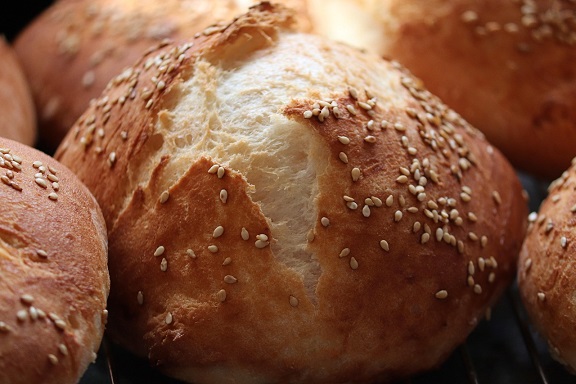
Golden, fluffy, and topped with a delicate crunch Sesambrötchen or German Sesame Rolls are a breakfast favorite throughout Germany. Whether picked up fresh from the local Bäckerei or baked at home, these soft-centered rolls with a crisp sesame-coated crust are a go-to accompaniment for butter, jam, cheese, or meats.
They’re not only easy to love – they’re surprisingly easy to make. Let’s dive into one of Germany’s most popular bread roll recipes.
The Origins of Sesambrötchen
While Brötchen (bread rolls) are a staple of German breakfasts, Sesambrötchen offer a tasty variation with their toasted nutty flavor and golden crust. You’ll find them stacked high in bakery baskets across the country, especially in western and southern Germany, where they’re enjoyed fresh daily with morning coffee or at Abendbrot (evening bread meals).
Sesame seeds were introduced into central European baking in the 19th century, and these rolls quickly became popular thanks to their subtle crunch and visual appeal.
Curious about more breakfast bakes? Check out our Dinkelbrot – Spelt Bread or Kartoffelbrot – Potato Bread.
Ingredients & Preparation (Step-by-Step Recipe Guide)
Ingredients for Authentic Sesambrötchen Recipe
- 500 g (4 cups) bread flour
- 1 packet (7 g) dry active yeast
- 10 g (2 tsp) salt
- 1 tsp sugar
- 300 ml (1¼ cups) warm water
- 2 tbsp neutral oil or melted butter
- Sesame seeds for topping
Optional tools: Baking sheet, parchment paper, kitchen scale, spray bottle for water
How to Make Sesambrötchen (Step-by-Step Instructions)
Step 1: In a bowl, dissolve yeast and sugar in warm water. Let stand for 10 minutes until foamy.
Step 2: Mix flour and salt in a large bowl. Add yeast mixture and oil. Knead until smooth and elastic, about 8–10 minutes.
Step 3: Cover and let rise in a warm spot for 1–1.5 hours until doubled in size.
Step 4: Divide dough into 8 equal portions. Shape each into a smooth ball or oval.
Step 5: Lightly spray or brush each roll with water. Dip tops into a plate of sesame seeds, then place seed-side up on a parchment-lined baking tray.
Step 6: Let rolls rest uncovered for 20–30 minutes. Preheat oven to 220°C (430°F).
Step 7: Score tops with a sharp knife and bake for 18–20 minutes, or until golden brown. Cool on a wire rack.
Tips:
- Use steam for a crisper crust: place a small dish of water in the oven.
- For extra softness, brush baked rolls with melted butter.
- Store in a cloth bag or freeze and reheat as needed.
Serving Suggestions & Variations
How to Serve Sesambrötchen
Serve warm with butter and honey, Nutella, or savory fillings like ham, cheese, and lettuce. Great for brunch platters, lunchboxes, or as burger buns.
Variations & Regional Twists
- Mohnbrötchen: Substitute sesame seeds with poppy seeds.
- Körnerbrötchen: Use a mix of seeds – sunflower, flax, sesame – for a multigrain twist.
- Mini Sesambrötchen: Make smaller rolls for party platters or sliders.
Sesambrötchen are a small but mighty addition to your bread-baking repertoire – crisp, fluffy, and incredibly versatile. Once you’ve tried them warm from your own oven, store-bought rolls just won’t compare.
Discover more classic loaves and traditional favorites on our German Bread Recipes page – your guide to rustic, regional, and everyday German baking.
Related Recipes:
Bauernbrot (Farmer’s Bread) Recipe – A rustic sourdough loaf made from rye and wheat, Bauernbrot is a German staple known for its hearty crust and tangy flavor.
Pumpernickel Recipe – Originating from Westphalia, this dense, dark rye bread is slow-baked for hours, developing its signature malty sweetness.
Vollkornbrot (Whole Grain Bread) Recipe – Packed with whole grains and seeds, this high-fiber loaf is favored for its nutty flavor and nutritional benefits.
Roggenbrot (Rye Bread) Recipe – A classic in German bakeries, Roggenbrot is typically sourdough-based and rich in earthy rye flavor.
Brötchen (Bread Rolls) Recipe – Crisp on the outside and soft within, Brötchen are the go-to breakfast rolls found on every German table.
Pretzels (Brezn) Recipe – Twisted and golden-brown, these iconic Bavarian soft pretzels are finished with salt and loved across the globe.
Schwarzbrot (Black Bread) Recipe – Made from coarse rye and sourdough starter, this dense loaf is especially popular in northern Germany.
Dinkelbrot (Spelt Bread) Recipe – Spelt-based with a light, nutty flavor, Dinkelbrot is an ancient-grain alternative enjoyed for its digestibility.
